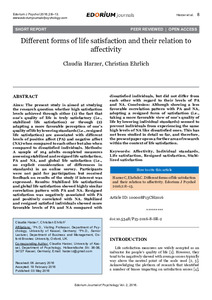| dc.date.accessioned | 2016-11-09T08:14:25Z | |
| dc.date.available | 2016-11-09T08:14:25Z | |
| dc.date.issued | 2016-05-03 | |
| dc.identifier.uri | urn:nbn:de:hebis:34-2016110951278 | |
| dc.identifier.uri | http://hdl.handle.net/123456789/2016110951278 | |
| dc.description.sponsorship | Gefördert durch den Publikationsfonds der Universität Kassel | |
| dc.language.iso | eng | |
| dc.rights | Urheberrechtlich geschützt | |
| dc.rights.uri | https://rightsstatements.org/page/InC/1.0/ | |
| dc.subject | Affectivity | eng |
| dc.subject | Individual standards | eng |
| dc.subject | Life satisfaction | eng |
| dc.subject | Resigned satisfaction | eng |
| dc.subject | Stabilized satisfaction | eng |
| dc.subject.ddc | 150 | |
| dc.title | Different forms of life satisfaction and their relation to affectivity | eng |
| dc.type | Aufsatz | |
| dcterms.abstract | Aims: The present study is aimed at studying the research question whether high satisfaction levels achieved through either (1) the fact that one's quality of life is truly satisfactory (i.e., stabilized life satisfaction) or through (2) adapting a more favorable perception of one's quality of life by lowering standards (i.e., resigned life satisfaction) are associated with different levels of positive affect (PA) and negative affect (NA) when compared to each other but also when compared to dissatisfied individuals.
Case Report: A sample of 104 adults completed measures assessing stabilized and resigned life satisfaction, PA and NA, and global life satisfaction (i.e., no explicit consideration of differences in standards) in an online survey. Participants were not paid for participation but received feedback on results of the study if interest was expressed.
Results: Stabilized life satisfaction and global life satisfaction showed highly similar correlation pattern with PA and NA. Resigned satisfaction was negatively associated with PA and positively correlated with NA. Stabilized and resigned satisfied individuals showed more favorable levels of PA and NA compared with dissatisfied individuals, but did not differ from each other with regard to their levels of PA and NA.
Conclusion: Although showing a less favorable correlation pattern with PA and NA, adopting a resigned form of satisfaction (i.e., taking a more favorable view of one's quality of life by lowering individual standards) seemed to prevent individuals from experiencing the same high levels of NA like dissatisfied ones. This has not been studied in detail so far, and therefore, the present paper opens a further area of research within the context of life satisfaction. | ger |
| dcterms.accessRights | open access | |
| dcterms.bibliographicCitation | In: Edorium Journal of Psychology. - Vol. 2.2016, S. 8-13 | |
| dcterms.creator | Harzer, Claudia | |
| dcterms.creator | Ehrlich, Christian | |
| dc.relation.doi | doi:10.5348/P13-2016-8-SR-2 | |

